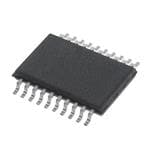PIC16LF1828T-I/SS
8-bit microcontrollers with 7KB Flash, 256B RAM, 32MHz internal oscillator
Manufacturer: microchip
series introduction
# Introduction to the PIC16LF1828T - I/SS Product Series
## 1. Overview
The PIC16LF1828T - I/SS is part of Microchip Technology's PIC16F family of 8 - bit microcontrollers. These microcontrollers are designed to offer a balance of performance, low power consumption, and rich peripheral features, making them suitable for a wide range of applications. The "LF" in the part number indicates that it is a low - power device, which is ideal for battery - powered or energy - sensitive applications.
## 2. Key Features
### 2.1 Core and Memory
- **CPU Core**: It is based on the high - performance RISC (Reduced Instruction Set Computing) CPU core. This architecture allows for fast execution of instructions, with most instructions being executed in a single cycle. The core has a wide range of instructions that enable efficient programming for various tasks.
- **Program Memory**: The PIC16LF1828T - I/SS comes with 14 KB of Flash program memory. Flash memory is non - volatile, which means that the program code stored in it is retained even when the power is turned off. This allows for easy reprogramming during development and in - field updates if required.
- **Data Memory**: It has 368 bytes of RAM (Random Access Memory). RAM is used for storing temporary data during the execution of the program, such as variables, intermediate results, and stack operations.
### 2.2 Low - Power Operation
- **Multiple Power Modes**: The device supports multiple power - saving modes, including Sleep mode. In Sleep mode, the microcontroller consumes extremely low power while still retaining the contents of its registers and memory. This makes it well - suited for applications where power consumption is a critical factor, such as wireless sensor nodes, wearable devices, and battery - operated remote controls.
- **Low - Voltage Operation**: It can operate at a wide range of supply voltages, typically from 1.8V to 5.5V. This flexibility allows it to be used in different power supply scenarios, whether it is powered by a single battery or a regulated power source.
### 2.3 Peripherals
#### 2.3.1 Timers
- **Multiple Timer Modules**: The PIC16LF1828T - I/SS is equipped with several timer modules, including Timer0, Timer1, and Timer2. These timers can be used for a variety of purposes, such as generating time delays, measuring time intervals, and generating PWM (Pulse Width Modulation) signals.
- **PWM Generation**: The timer modules can be configured to generate PWM signals, which are commonly used for controlling the speed of motors, adjusting the brightness of LEDs, and implementing analog - like control in digital systems.
#### 2.3.2 Communication Interfaces
- **USART (Universal Synchronous/Asynchronous Receiver/Transmitter)**: It has a USART module that supports both synchronous and asynchronous serial communication. This allows the microcontroller to communicate with other devices, such as computers, sensors, and actuators, using standard serial communication protocols like RS - 232, RS - 485, or TTL - level serial.
- **SPI (Serial Peripheral Interface)**: The SPI interface provides a high - speed, synchronous serial communication option. It is commonly used for communicating with external devices such as EEPROMs, ADCs (Analog - to - Digital Converters), and DACs (Digital - to - Analog Converters).
- **I²C (Inter - Integrated Circuit)**: The I²C interface is a multi - master, multi - slave serial communication protocol. It is widely used for connecting low - speed devices,
Images for reference

20-SSOP

Image Preview